Touring in Normandy
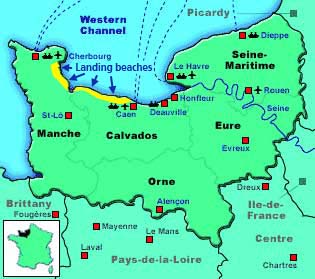
Yes, we are aware that we have not posted in a long time. What can I say—we are just having too much fun. In France, the life social, cultural, and intellectual picks up in a big way after September 1. July and August are vacation time, so only now are we able to attend meetings of the camera club, the archeology society, etc. We have discovered the Echanges de Savoirs (“knowledge exchange”), and Madeline is now teaching Photoshop to the French in exchange for getting lessons in crêpe making, among other things. We also have a weekly French conversation class and are in a book club. Madeline is doing a lot more, but I’ll let her tell you (click here).
The week before last, we spent four days with my uncle, Alvin, in Normandy, the province just east of us. We concentrated on the D-Day sites and Caen and Bayeux, two cities associated with William the Conqueror. William defeated the English at the Battle of Hastings in 1066, adding the title of King of England to his position as Duke of Normandy. It was a most fascinating trip.
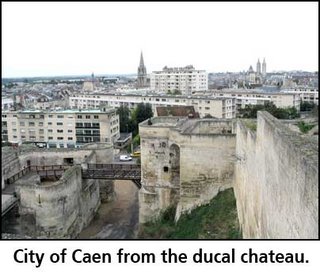
The Dukes ruled Normandy from their château-castle in the city of Caen, which also was the center of a ferocious WWII battle. German defenders of the city held off British and Canadians forces for 40 days after the successful June 6, 1944, landings. About three-quarters of Caen’s buildings were left in rubble, although some important medieval landmarks remained. The château of the dukes has been restored and provides a great vantage point for panoramas of the city. Postwar buildings dominate the vista, but major monuments like the two abbeys founded in the 11th century survive.
William had married his cousin, Mathilde, which qualified as incest in the eyes of the church. To expiate this sin, William an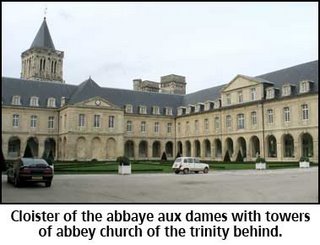 d his bride established abbeys in Caen, one for men and the other for women (l’abbaye aux hommes and the l’abbaye aux dames). Each abbey was anchored by a magnificent church in the Norman style, characterized by round-headed arches and ornamental schemes that are often abstract geometric forms. An example is the squiggly line (known as a chevron) in the capital shown here. The other buildings of the abbaye aux dames were replaced in the 18th century and now house local government offices. The former cloister is an imposing example of the more restrained side of French architecture in the 18th century.
d his bride established abbeys in Caen, one for men and the other for women (l’abbaye aux hommes and the l’abbaye aux dames). Each abbey was anchored by a magnificent church in the Norman style, characterized by round-headed arches and ornamental schemes that are often abstract geometric forms. An example is the squiggly line (known as a chevron) in the capital shown here. The other buildings of the abbaye aux dames were replaced in the 18th century and now house local government offices. The former cloister is an imposing example of the more restrained side of French architecture in the 18th century.
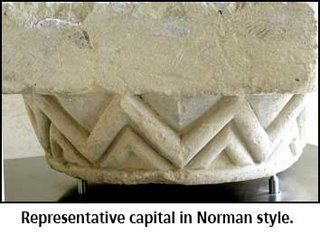
William’s half-brother, Odo, was bishop in Bayeux, near Caen, and began the construction of the awesome cathedral there. It may also have been Odo who commissioned the Bayeux Tapestry, which is not a tapestry (rather an embroidery) and was most likely made in England, not France. The tapestry recounts the struggle over the succession to the crown of England, decisively terminated by the 1066 Norman invasion of England and William’s becoming king. The tapestry is very well preserved and includes depictions of medieval life—peasants plowing fields, carpenters making boats, soldiers cooking meals—that are a priceless window into the past. The tapestry is more than 250 feet long, and one walks slowly through the gallery taking in the events depicted.
Bayeux, just 7 miles from the sea, was captured within 48 hours of the D-Day landings and so escaped damage. It is a charming small city and our base for two days of touring the invasion beaches and associated sites. We had an excellent dinner in Bayeux at Le Pommier, located quite appropriately on the Rue de Cuisiniers.
The Allies stormed ashore in June 1944 on five beaches across a 50-mile front in Normandy. We stopped at all of them. Formerly, my mental images of D-Day centered on landing craft spitting troops out on barren sandy beaches. It was interesting to learn that the British and Canadians landed in some seaside resort towns and almost immediately were fighting the Germans from house to house. Many of the concrete bunkers and gun emplacements built by the Germans remain. Some seem so solid that they will no doubt be around a thousand years from now. 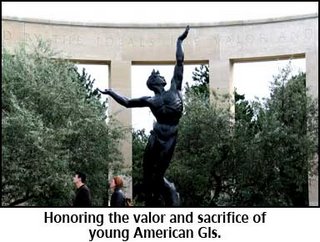
We visited several cemeteries, a very moving experience. Also interesting to note the differences in approach among the U.S., Commonwealth, and German ones. The Canadian and British headstones include details of unit affiliation and often a brief inscriptio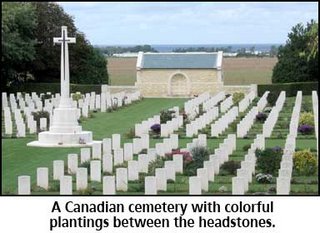 n chosen by the family. This makes them more personal than the U.S. headstones, although the limited information on each U.S. stone emphasizes the idea of death as the great leveler, making details of rank and unit meaningless. The American cemetery overlooking Omaha Beach is the most heavily visited one. It is also the only one we encountered that attempted to tell the military history of the battle for France in 1944. The semicircular colonnade surrounding the statue representing American youth shelters large campaign maps. Viewing the ocean of headstones at each cemetery is a sobering reminder of all the young lives that were cut short in those months of vicious combat in 1944.
n chosen by the family. This makes them more personal than the U.S. headstones, although the limited information on each U.S. stone emphasizes the idea of death as the great leveler, making details of rank and unit meaningless. The American cemetery overlooking Omaha Beach is the most heavily visited one. It is also the only one we encountered that attempted to tell the military history of the battle for France in 1944. The semicircular colonnade surrounding the statue representing American youth shelters large campaign maps. Viewing the ocean of headstones at each cemetery is a sobering reminder of all the young lives that were cut short in those months of vicious combat in 1944.
We stopped at two other places that figured in the battle for Normandy. Anyone old enough or film buff enough to have seen The Longest Day will remember Red Buttons as an American paratrooper whose chute gets caught on a pinnacle of a village church. He then plays dead for several hours to avoid being shot up by the Germans. Unlike some scenes in the film, this incident actually occurred, and the town of St-Mère-Eglise is not likely to let anyone forget the fact. Right there in the center of town, a dummy dressed as paratrooper John Steele dangles in perpetuity at the corner of the church. The American airborne forces that landed in and around St.-Mere-Eglise rapidly linked up with the troops driving west from Utah beach and began to consolidate the area of Allied control toward the western end of the invasion area.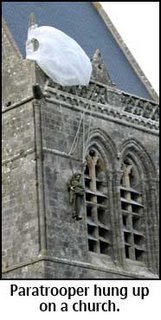
The city of St.-Lo was a critical transportation hub that the Allies needed to take in order to cut the Germans off in the Contentin Peninsula and capture the port of Cherbourg. The British constructed two amazing temporary ports that were prefabricated by 30,000 w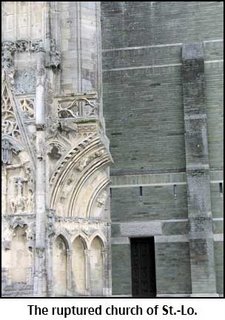 orkers, shipped in pieces across the channel, and assembled within a week or so of D-Day. The remains of the “temporary” harbor at Arromanches are clearly visible. Supporting the hundreds of thousands of troops in France ultimately required the securing of an existing port, and Cherbourg was the place. The battle for St.-Lo was bloody and grim, leaving a great deal of the town in ruins. Reminders of that awful time include the wall of a prison where French prisoners of the Nazis died during the bombing that preceded the American ground attack. The residents also decided not to completely restore their church of Notre-Dame but to repair some of the damage with modern materials. The abrupt transition from medieval stone to twentieth-century concrete underscores the rupture in the life of the town and the horrible costs of war.
orkers, shipped in pieces across the channel, and assembled within a week or so of D-Day. The remains of the “temporary” harbor at Arromanches are clearly visible. Supporting the hundreds of thousands of troops in France ultimately required the securing of an existing port, and Cherbourg was the place. The battle for St.-Lo was bloody and grim, leaving a great deal of the town in ruins. Reminders of that awful time include the wall of a prison where French prisoners of the Nazis died during the bombing that preceded the American ground attack. The residents also decided not to completely restore their church of Notre-Dame but to repair some of the damage with modern materials. The abrupt transition from medieval stone to twentieth-century concrete underscores the rupture in the life of the town and the horrible costs of war.
On our way from Normandy to Lannion, we stopped at le Mont St. Michel, the monastery on an island that seems to grow directly out of the rock. The flat salt marshes surrounding the mont make it visible for many miles. We approached it from the east late in the day and tried to imagine the effect the scene might have had on a pilgrim 500 years or so ago. At Mont St. Michel, all of the spaces needed by the monks that ordinarily would have covered acres of ground are stacked on top of one another. These include a dining hall, reception room, scriptorium where books were copied, and a cloisters that opens out to a sweeping vista of the sea.
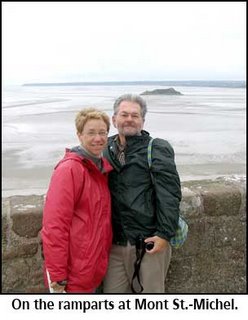
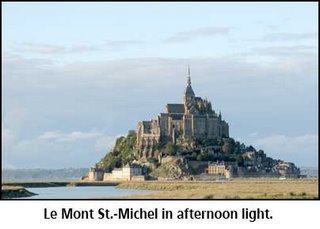
We stayed at a delightful bed and breakfast on the road to Mont St. Michel. The owner, Danielle, greeted us as the “faux Bretons,” based on my e-mail seeking reservations. I wrote in French using our Lannion address, but there is no concealing the fact that I am an American struggling with the language of the Gauls. Our rooms were on the second floor of an older house, pleasantly furnished, and spacious. That evening, we at last had a chance to try the famous pre-salted lamb of the Bay of St. Michel. The meadows where the lambs graze flood periodically, and the grass is impregnated with salt water. So the meat is pre-salted. It was delicious, both in a ragout and grilled. Also consumed with pleasure were oysters and mussels raised in the bay.
Another way station on the trip home was the town of Villedieu-les-Poëles, literally, the Lord’s city of cooking pots. The town has been a center of metal-working for centuries. It has many shops selling copper cookware as well as one of only three bell foundries still operating in France (there were some 200 on the eve of the Revolution in 1789). We availed ourselves of a tour of the foundry, where we saw bells destined for a town in California and a mission church in Cameroon.
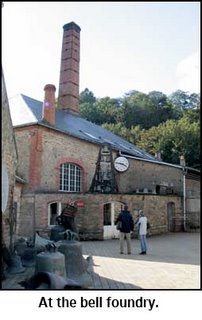
 In Villedieu we also visited a wine and spirit merchant who delighted in explaining to us the intricacies of Calvados, a brandy distilled from apple cider that, like bourbon, is clear when it is distilled and then is aged in oak casks. The Calvados emerges a mellow brown color. The best Calvados is aged at least 12 years. Our new friend also told us about his mother’s experiences with American GIs in 1944-1945. The GIs were welcomed, but regrettably, they gave his mom free cigarettes and she got hooked.
In Villedieu we also visited a wine and spirit merchant who delighted in explaining to us the intricacies of Calvados, a brandy distilled from apple cider that, like bourbon, is clear when it is distilled and then is aged in oak casks. The Calvados emerges a mellow brown color. The best Calvados is aged at least 12 years. Our new friend also told us about his mother’s experiences with American GIs in 1944-1945. The GIs were welcomed, but regrettably, they gave his mom free cigarettes and she got hooked.Our touring with my uncle in Brittany occupied another few days, but that will have to wait for another entry.
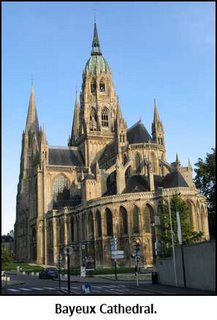

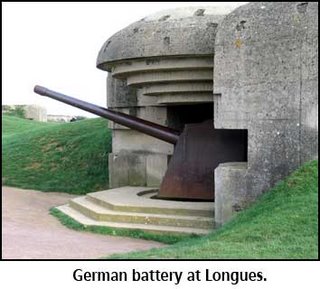
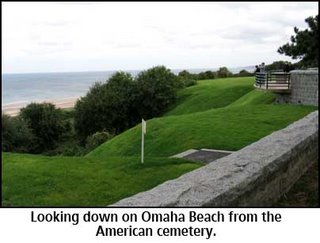
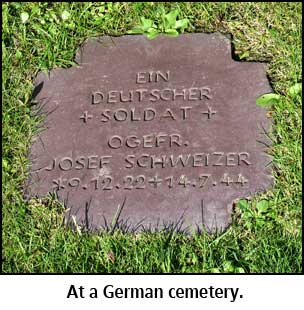
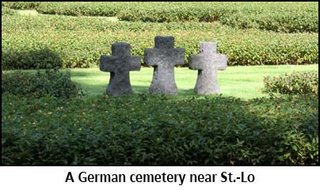

6 Comments:
Beautiful, sobering, inspiring photos. Wow, fresh oysters and naturally sea-salted grass-fed lamb....YUM! Ellen and I obviously need to return to complete our research.
-Martin
Thanks for posting again. I like the idea of Madeline teaching Photoshop in return for crepe-making lessons! When you get a chance, perhaps you could post something (with pictures!) to update us on your progress in cataloging Gérald's library.
Chris
Hey - Great to see you are enjoying yourselves!! Nothing like a few "good" military or religious sites to put things in perspective. Stay well!
allen y margo
You did a fantastic job of recounting our time in Normandy. It was all memorable but experiencing the D-Day invasion beaches and cemeteries lingers most in my mind. How fortunate I am to have shared all of it with the two of you. Love, Al
I'm catching up on my blog reading...how very moving. I was just a teeny bit envious of your visit to Normandy. Thank you for the vicarious visit.
We are friends of your uncle Alvin's and were excited to read your account of his visit and your adventures together. For me, it brought back memories of 40 years ago when I lived in France and visited those same places. You have rendered the Normandy experience so vividly that I am inspired to go back!
Post a Comment
<< Home